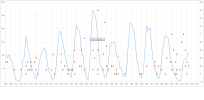Couldn't help but try plotting some of the data comparing sunspot number to the number of earthquakes, going back to 1900.

Seems like there is indeed a link between the two, with the number of earthquakes picking up when solar activity starts dropping after having reached a maximum. The only exceptions to this are the periods spanning the 1940s and the 1970s, although the overall trend is clearly evident during the last 3 solar cycles, where more accurate data is available.
Still eager to see Altair's findings which should provide a better view from an historical perspective.

Seems like there is indeed a link between the two, with the number of earthquakes picking up when solar activity starts dropping after having reached a maximum. The only exceptions to this are the periods spanning the 1940s and the 1970s, although the overall trend is clearly evident during the last 3 solar cycles, where more accurate data is available.
Still eager to see Altair's findings which should provide a better view from an historical perspective.




